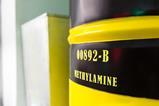When the numbers don’t add up, chemists must restore the balance

Chemists often say that chemistry is like cooking, but chemistry seems to have more interesting pitfalls.
Imagine baking a cake – mixing the butter and sugar, adding the eggs, flour, baking powder and milk, pouring out the batter and putting it in the oven until soon the smell of a risen cake permeates the house. Now imagine your surprise when you open the oven door, to find that instead of a large beautiful cake, there is barely enough for a couple of bites.
Unless a worm hole opened inside the reactor, the mass of the starting materials must equal the mass of the product, side products and impurities
Luckily for home cooks, this just isn’t the way that cooking fails. Food might be too raw, burnt or maybe too salty, but everything you started with is there at the end. Laboratory chemistry is one of those places where that’s not always the case. You can open the laboratory vacuum oven, or peer at the Büchner funnel, or worse yet, watch your material gather in the centrifuge basket, and realise that there’s not very much there – sometimes kilograms less than expected. Where did it all go?
And it has to go somewhere – Antoine Lavoisier had something to say about mass being conserved. So unless a worm hole temporarily opened inside the reactor, the mass of the starting materials must be represented in the mass of the product, side products and impurities somewhere in the streams produced in the run. When thousands of dollars of product are missing, mass balance becomes all-important.
So the hunt begins. For a typical synthetic organic reaction, you start with the usual suspects: the filter paper or the centrifuge basket. If it’s not there, it’s probably in the mother liquor for the crystallisation. If you still can’t find it, it might be in the water washes, or perhaps it didn’t become product at all. Vacuum distilling the mother liquors, or worse, the water washes, might be the next step.
Analytical chemistry is essential in finding your missing mass. To be able to know how much is missing, you need to be able to measure your compound in a solvent. Ideally, you’ll have established quantitative measurements for your gas or liquid chromatography traces ahead of time. For lower boiling compounds, gas chromatography works well for analysing purity. But after a brief afternoon of weighing out standards and injecting them, you can even construct a method to quantify chemicals on the gas chromatograph. You can do the same for HPLC.
If even analytical chemistry fails to help find all of your missing product, then it’s time to scour the reactor. As reactors get bigger, there are more places where material can hide. Got a volatile compound? Check the piping above the reactor – hopefully, it’s caught in the condenser or the ‘dead leg’ flat spots in the pipes. Considering that most piping in the plant is steel, you can’t see it, and if you can’t see it, you can’t find it.
Is your product sticky? Then check the ceiling: plant operators who prefer high rates of agitation can end up distributing product all over the reactor. Again, that pesky metal reactor, where you cannot see the top, is to blame. The 30cm gap between the top of the manway and the top of the reactor means that kilograms of your precious product could be stuck up there, with no really good way to remove it. And you’ll need to get out a mirror on a telescoping pole and a flashlight to find it.
Once you see that material has collected somewhere else, you have to go and get it. No one wants an operator in a safety suit scraping reactor walls. Rather, it’s a better idea to add a solvent that will dissolve the product when hot, and crystallise it as a well-behaved, filterable solid when cold.
When you know you are missing some product in a full mass balance, there is an odd, almost eerie feeling as you comb through the data, looking for a place where you might have made an error. Each product stream gets reweighed, each analysis gets rerun until it makes sense. When you eventually discover the compound unexpectedly in a water layer or when you are missing 7kg and you find 6.9kg stuck to the reactor walls, there is a distinct feeling of relief as if everything is right with the world once more. The masses are in balance again.

















No comments yet